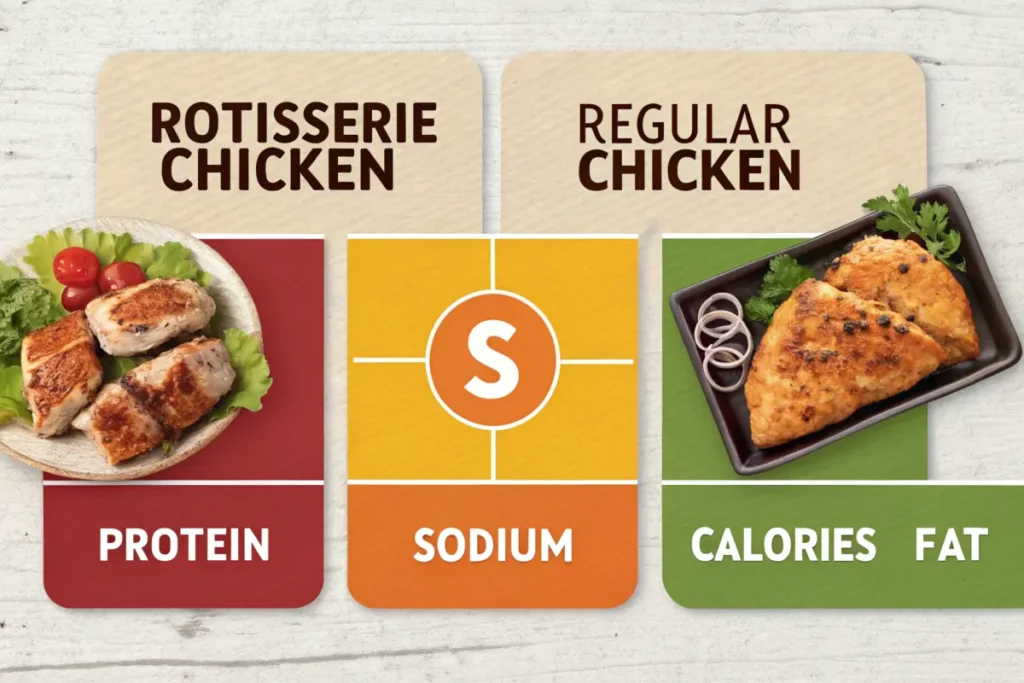Rotisserie chicken has become a go-to option for quick and convenient meals, while chicken breast remains a staple for those aiming to eat clean. But when it comes to health, is rotisserie chicken just as healthy as chicken breast? The answer isn’t as simple as it seems. In this article, we’ll explore the nutritional differences, health benefits, and drawbacks of both, helping you make informed choices for your meals.
Let’s dive into a detailed comparison, starting with an overview of these popular protein sources.
Overview of Rotisserie Chicken vs. Chicken Breast
Nutritional Composition Comparison

When it comes to nutritional value, both rotisserie chicken and chicken breast are high in protein, but they’re not created equal. Chicken breast is known for being lean, with minimal fat and calories. In contrast, rotisserie chicken can have higher fat content due to added seasonings and cooking methods.
While a 3-ounce serving of plain chicken breast contains around 110 calories, 26 grams of protein, and less than 2 grams of fat, rotisserie chicken often packs more calories and fat. Why? The skin and marinades used in rotisserie chickens significantly contribute to their fat and sodium levels, making them less lean than their skinless counterparts.
Additives and Sodium Content in Rotisserie Chicken

A major difference lies in the hidden extras found in rotisserie chicken. Store-bought versions are frequently seasoned with salt-heavy brines or marinades. This boosts the sodium content, which can exceed 500 mg per serving in some cases. Additives like phosphates and preservatives are often used to maintain moisture and enhance flavor, potentially causing health concerns for those with sensitivities.
In contrast, plain chicken breast prepared at home gives you control over what’s added. You can skip the brines and instead use natural herbs and spices for flavor, ensuring a healthier dish overall.
Health Benefits of Chicken Breast
Lean Protein Source
Chicken breast is often hailed as one of the healthiest protein options, and for good reason. It’s a lean source of protein, meaning it provides the building blocks for muscle repair and growth without excess fat. For every 3-ounce serving of chicken breast, you’ll get about 26 grams of high-quality protein with less than 3 grams of fat. This makes it an ideal choice for anyone focused on maintaining a healthy weight or building muscle.
Moreover, chicken breast is versatile and can be cooked in countless ways to suit any meal plan. Whether you’re grilling, baking, or poaching, you can enjoy a meal that’s low in calories yet packed with nutrients. Compared to rotisserie chicken, it’s much easier to control the ingredients and cooking methods when preparing chicken breast at home. So, is rotisserie chicken just as healthy as chicken breast? In terms of protein and fat content, chicken breast often wins.
Low Fat and Calorie Count
Another standout feature of chicken breast is its low-fat profile. Unlike rotisserie chicken, which often includes the skin and added fats from cooking oils or marinades, chicken breast offers a cleaner nutritional slate. A single serving contains around 110 calories and less than 1 gram of saturated fat. This makes it a great option for heart health and weight loss.
If you’re watching your calorie intake, skinless chicken breast is a straightforward way to stay within your limits. Unlike rotisserie chicken, which might have hidden fats and seasonings, chicken breast provides pure protein with fewer surprises. You can make it even healthier by pairing it with fiber-rich sides like quinoa or leafy greens.
The Advantages of Rotisserie Chicken
Convenience and Accessibility
There’s no denying that rotisserie chicken is a lifesaver for busy days. It’s already cooked, seasoned, and ready to eat, saving you time in the kitchen. For those with hectic schedules, it’s a convenient way to add protein to meals without much effort. You can slice it for salads, shred it for tacos, or enjoy it as a quick main dish.
Additionally, rotisserie chickens are widely available at most grocery stores and often come at an affordable price. This accessibility makes them a popular choice for families and individuals who want to eat better without spending hours cooking. But is rotisserie chicken just as healthy as chicken breast? While it’s undeniably convenient, the added sodium and fats mean you should consume it in moderation.
Retaining Essential Nutrients
Despite its drawbacks, rotisserie chicken does have nutritional benefits. Chicken is naturally rich in protein, vitamins, and minerals, and these nutrients are retained during the cooking process. A 3-ounce serving of rotisserie chicken provides approximately 23 grams of protein, along with B vitamins and essential minerals like selenium and phosphorus.
However, to maximize these benefits, it’s best to remove the skin and trim any visible fat. This simple step reduces the calorie and fat content while preserving the essential nutrients. Rotisserie chicken is a practical choice for those who need a quick meal solution without sacrificing their dietary needs entirely.
Drawbacks of Rotisserie Chicken
Sodium Overload and Its Risks
While rotisserie chicken is a convenient and tasty option, it often contains high levels of sodium. Most store-bought rotisserie chickens are heavily seasoned or brined before cooking, significantly increasing their sodium content. Consuming too much sodium can contribute to high blood pressure, which raises the risk of heart disease and stroke.
Moreover, those on low-sodium diets need to be particularly cautious. A single serving of rotisserie chicken may already account for a significant portion of your daily sodium allowance. Reducing the intake of the skin, where much of the seasoning is concentrated, can help lower sodium consumption. To strike a balance, consider pairing rotisserie chicken with low-sodium side dishes like steamed vegetables or a fresh salad.
Potential Additives and Health Concerns
Another concern with rotisserie chicken is the potential presence of additives. To enhance flavor, extend shelf life, or maintain moisture, manufacturers often use preservatives and artificial flavorings. These substances may cause adverse reactions, especially in individuals sensitive to such ingredients.
For example, phosphates are sometimes added to improve the chicken’s texture but can negatively affect kidney health if consumed in excess. Additionally, MSG and other flavor enhancers can lead to headaches or allergic reactions in some people. Reading the label and choosing chickens with minimal additives can help mitigate these risks.
For more delicious recipes and healthy meal ideas, explore our recipe collection.
Cooking Your Own Chicken Breast: A Healthier Alternative?

Control Over Ingredients
Cooking your own chicken breast gives you complete control over what goes into your meal. Unlike store-bought rotisserie chicken, which often includes high levels of sodium and artificial additives, homemade chicken breast can be tailored to your dietary needs. By using simple seasonings like herbs, spices, and a pinch of salt, you can enjoy flavorful meals without compromising health.
This level of control also allows you to explore different marinades and cooking techniques. For example, a lemon-garlic marinade can infuse chicken breast with bold flavors while keeping the dish healthy. Such customization ensures that you know exactly what you’re eating, making it easier to stick to specific dietary goals.
Variety in Cooking Methods
One of the great advantages of preparing chicken breast at home is the variety of cooking methods available. Baking, grilling, and poaching are excellent options for retaining nutrients while achieving delicious results. Each method provides a unique flavor and texture, offering flexibility for any meal.
Moreover, these cooking techniques can significantly reduce the amount of added fat compared to frying. For instance, grilling adds a smoky flavor without requiring much oil. On the other hand, poaching is ideal for creating tender, juicy chicken that can be shredded and added to salads or soups.
For more tips on cooking flavorful chicken meals, check out our recipe ideas.
FAQs About Rotisserie Chicken and Chicken Breast
How Does Rotisserie Chicken Compare to Home-Cooked Chicken Breast in Sodium Content?
One of the most common questions people ask is, “Is rotisserie chicken just as healthy as chicken breast?” When it comes to sodium content, the answer often leans toward home-cooked chicken breast. Store-bought rotisserie chicken is usually seasoned with salt-heavy marinades or brines, making it much higher in sodium compared to plain chicken breast prepared at home. If you’re watching your sodium intake, roasting or grilling chicken breast with minimal seasoning is a better option.
Is Rotisserie Chicken a Good Option for Weight Loss?
Rotisserie chicken can fit into a weight-loss diet, but portion control is key. The protein in rotisserie chicken supports muscle retention and satiety, helping curb hunger. However, the higher fat and calorie content—especially in the skin—means that eating large quantities can hinder weight-loss efforts. For a leaner choice, stick to skinless chicken breast, which is naturally lower in fat and calories.
What Are the Best Ways to Balance Rotisserie Chicken in a Healthy Diet?
If rotisserie chicken is your go-to meal, balance it with nutrient-rich, low-sodium sides like steamed vegetables, whole grains, or fresh greens. This helps offset the higher sodium levels while ensuring a well-rounded meal. Removing the skin can also reduce the fat content, making it a slightly healthier choice.
Can Rotisserie Chicken Be Part of a Heart-Healthy Diet?
While rotisserie chicken can provide lean protein, the added sodium and potential preservatives make it less heart-friendly compared to chicken breast. To enjoy rotisserie chicken in a heart-healthy way, limit your intake and combine it with potassium-rich foods like avocados or bananas to counteract sodium’s effects.
Conclusion and Practical Takeaways
Choosing Between Rotisserie Chicken and Chicken Breast
Deciding between rotisserie chicken and chicken breast often depends on your priorities. If convenience is your main concern, rotisserie chicken is a quick and flavorful option. However, for those focused on healthier eating, chicken breast prepared at home is the better choice. By controlling ingredients and cooking methods, you can create meals tailored to your dietary needs.
Tips for Making Rotisserie Chicken Healthier
If you choose rotisserie chicken, there are simple steps to make it a healthier addition to your meals. Start by removing the skin, where much of the fat and seasoning are concentrated. Pair it with fresh vegetables and whole grains to create a balanced plate. Drinking plenty of water can also help flush out excess sodium.
Ultimately, the question “Is rotisserie chicken just as healthy as chicken breast?” depends on how it’s prepared and consumed. Both options can be part of a healthy diet when eaten mindfully, making it easier to enjoy delicious and nutritious meals.
Would you like further elaboration on any of these points?
Nutritional Comparisons for Special Diets
Is Rotisserie Chicken Just as Healthy as Chicken Breast for Low-Carb Diets?
For those following a low-carb diet, both rotisserie chicken and chicken breast are excellent sources of protein. However, the choice often comes down to added ingredients. Rotisserie chicken can sometimes include sugary glazes or seasonings that increase its carbohydrate content. On the other hand, plain chicken breast prepared at home contains no hidden carbs, making it a safer option for strict low-carb eaters. To ensure your meal aligns with your diet, check the nutrition label on store-bought rotisserie chicken.
Which Option Works Better for High-Protein Diets?
Both rotisserie chicken and chicken breast deliver high amounts of protein, which is essential for muscle building and overall health. The question, “Is rotisserie chicken just as healthy as chicken breast?” comes into play when factoring in the additional calories from fat in rotisserie chicken. Chicken breast, being leaner, allows you to consume more protein without exceeding your calorie goals. If protein is your main focus, chicken breast may provide more flexibility in your meal planning.
Practical Cooking Tips for Healthier Chicken Dishes
Enhancing the Nutritional Value of Rotisserie Chicken
While rotisserie chicken is a convenient choice, there are simple ways to improve its nutritional profile. Start by removing the skin to reduce fat and sodium intake. Pair it with fiber-rich vegetables or whole grains, which can balance the meal and make it more filling. Adding fresh herbs or a squeeze of lemon juice can also enhance flavor without extra calories or unhealthy additives.
Creative Ways to Use Chicken Breast in Your Meals
Chicken breast is incredibly versatile and adapts well to a variety of dishes. Baking or grilling it with a mix of herbs and spices can create flavorful, healthy meals. Alternatively, shredded chicken breast works well in soups, salads, or even tacos. Preparing chicken breast in advance and storing it in portions can also save time while ensuring you have healthy meal options throughout the week.
“Is rotisserie chicken just as healthy as chicken breast?” is a nuanced question, but with mindful preparation, both can contribute to a balanced diet. Rotisserie chicken offers convenience, while chicken breast provides greater control over ingredients and nutrition. Choosing the option that aligns with your health goals ensures you enjoy meals that are both delicious and good for you.

